ISSUES OF CARIBBEAN AREA AND INSERTION IN THE PROCESS OF GLOBALIZATION.
Before studying deeply the insertion of Caribbean basin into the globalization, I do believe it’s necessary to develop the first part of my presentation on the concerns of these islands which suffered from.
Caribbean countries are vulnerable to natural hazards because :
- the are close to plate boundaries – risk zones for earthquakes and volcanic eruptions,
- they have hurricanes and intense rainfall
- most people live close to the sea
- many people live on steep slopes subject to landslides, or on flat close to sea level
- humans have greatly altered the Caribbean environment, forests and coastal mangroves have been removed.
the risk is increasing worldwide due to
- economic development more buildings, roads, infrastructures,
- people build in hazardous places,
- climate change increasing the risk of extreme events such as drought and hurricanes.
The disaster risk and economic development
Most financial damage is in wealthy countries. From 1985 to 1999, the HIC suffered 57% of the financial loss from disasters. They are more property to lose. But poorer nations are less able to afford their losses. From 1985 to 1999, the HIC lost 2.5 % of GDP from natural disaster. LIC lost 13%. Deaths are numerous in LIC (97% of the total) . Indeed, buildings are weaker, infrastructures easily destroyed and emergency more difficult.
Small islands are more vulnerable than larges ones. Hurricane Ivan, in 2004, hit Grenada coast to coast. Montserrat was hit by Hurricane Hugo in 1989, and again by the volcanoe in 1994.
ISSUES AND MAPS


Explain why do you have conflicts between countries concerning EEZ in this area ?
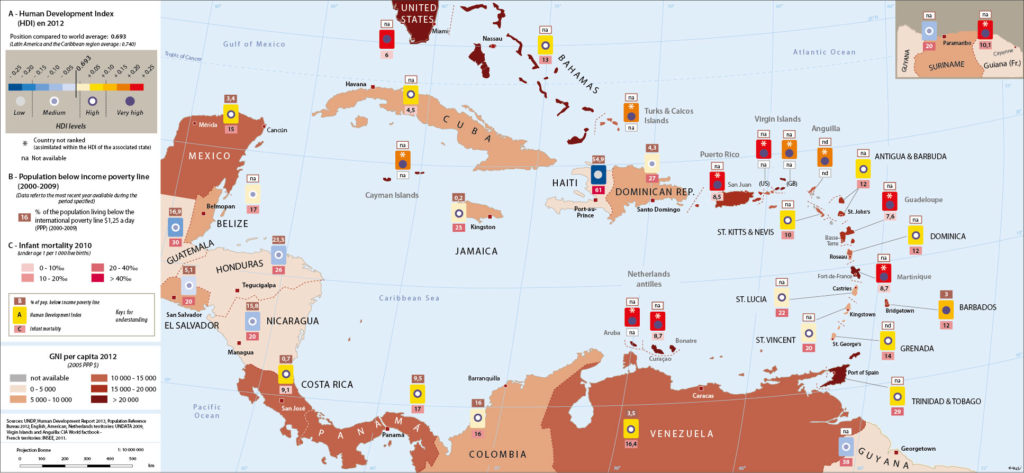
Using the HDI map, prove that the Caribbean Basin is composed of MDCs and LDCs as well.
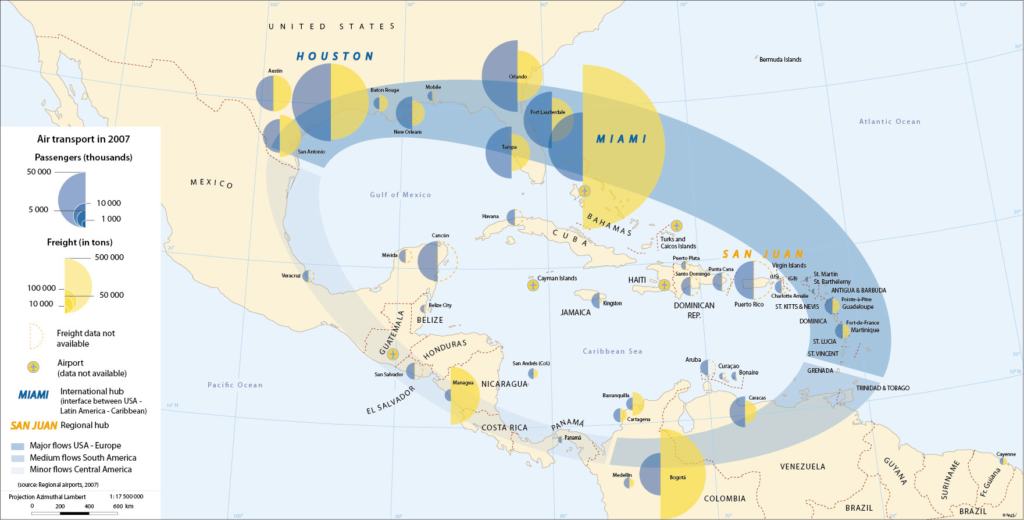
Prove that the Caribbean Basin is well integrated in the world aerial traffic

poppy is useful to produce opium or heroin.
Prove that the Caribbean Basin is integrated to the world financial exchanges and is a corridor for illegal flows.
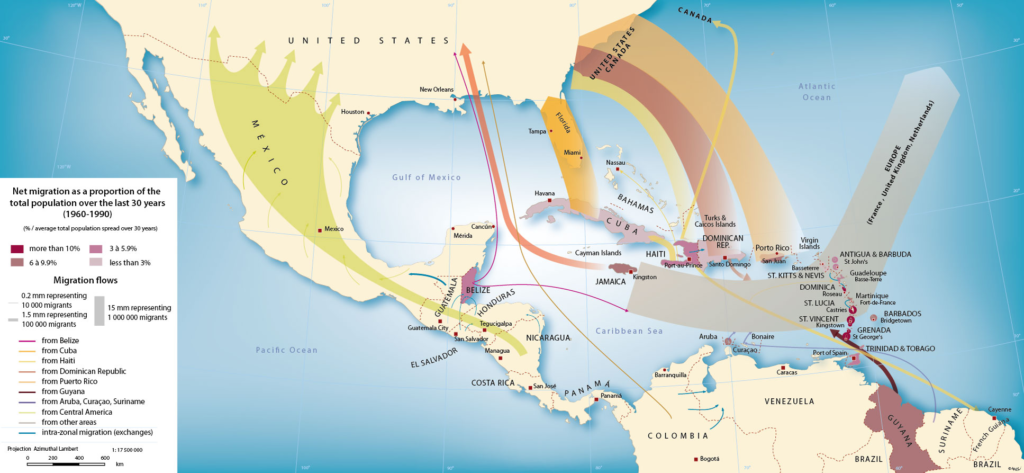
Prove that the Caribbean Basin is a corridor for international migrations.
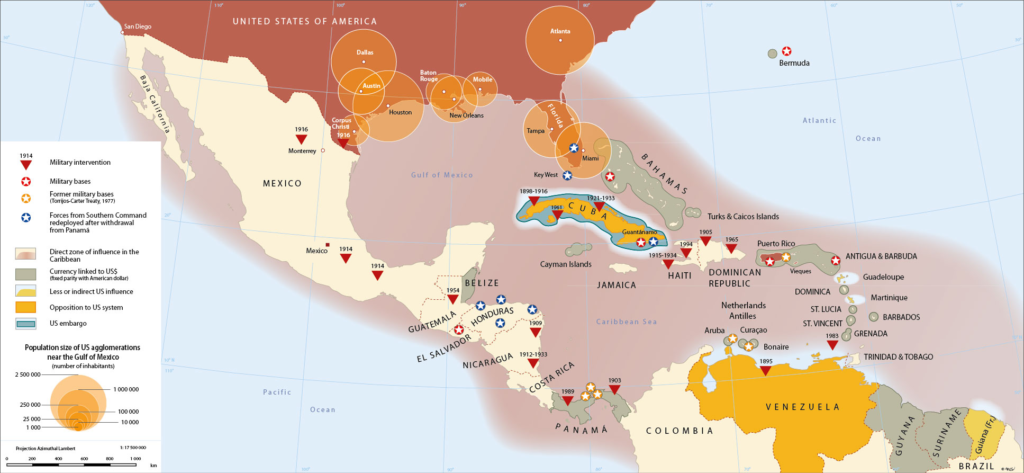
Show the influence of the US at all levels in the basin and the different forms of opposition.

Prove that the Caribbean Basin in a major pole for the transport of merchandises in the world.

Prove that the Caribbean Basin is well integrated in the world aerial traffic
Final Problematic : In what ways the Caribbean basin could be considered as an American and world interface?
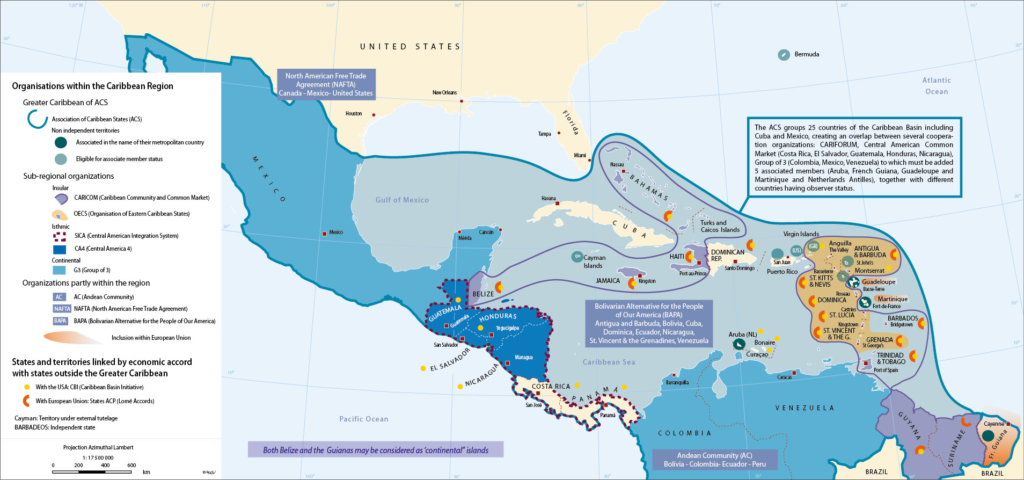
Nafta is replaced by USCMA (United Stated Canada Mexico Agreement)
Why this area is so fragmented ? The only common point really visible between the countries from the Caribbean Basin is history and the fact that they are all linked to the Gulf of Mexico and the Caribbean Sea. Indeed, all these countries, at one time or another from their history were colonies from a European country, mainly Spain, France and England. Many attempts for creating a common economic organisation were made but actually they were several from CARICOM (Caribbean Community and Common Market), OESC (Organisation of Eastern Caribbean States, SICA (Central American integration System), ACS (Association of Caribbean States), USCMA (United States Canada Mexico Agreement), … None of them completely integrate all the Caribbean states except the ACS but its powers and means of action are weak. Moreover, the Islands are also a part of AOSIS (Alliance of Small Islands States) which group 49 small islands all over the world which try to be recognised for their problems and characteristics. So we can say that geographically, politically and economically speaking, whatever the common Caribbean culture, the Caribbean basin is a fragmented space.
The Caribbean Basin is a peculiar region:
- Its landmass is half mainland, half islands.
- It’s closed and open at the same time.
- It’s Atlantic, but opened to the Pacific.
- It used to be under European control and is now under US influence but Brazil is vying for more
power in the region. - Most of the countries belong to the LDCs but it’s closely linked to the MDCs
- The Caribbean basin can only be considered as a fragmented space geographically speaking because of the large number of Islands and Islets composing a part of its organisation and because of the differences from size, population, power and development between the countries belonging to it. However some elements can be considered as keys to define what the Caribbean Basin is : two seas, the Caribbean Sea and the Gulf of Mexico because only territories connected to them can be considered a part of the Caribbean Basin. Moreover, it’s history and identity which define the best what the Caribbean Basin is. Indeed, all the countries from that region where colonised by European powers : France, England and Spain for the most important.
ORGANISATIONS IN THE CARIBBEAN BASIN
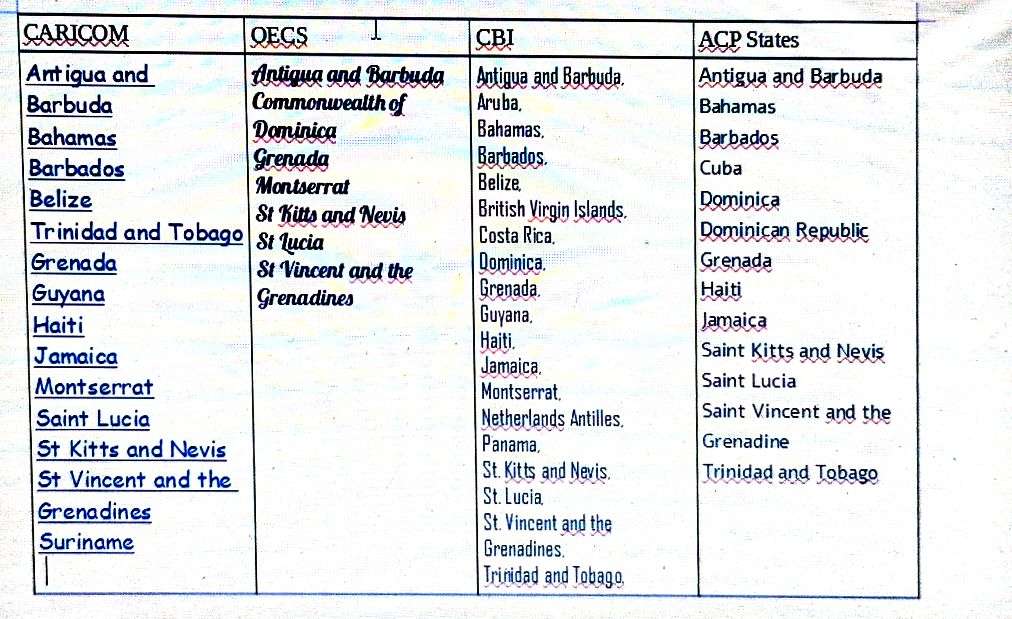
In the Caribbean Basin, the islands were organized in associations. Here there
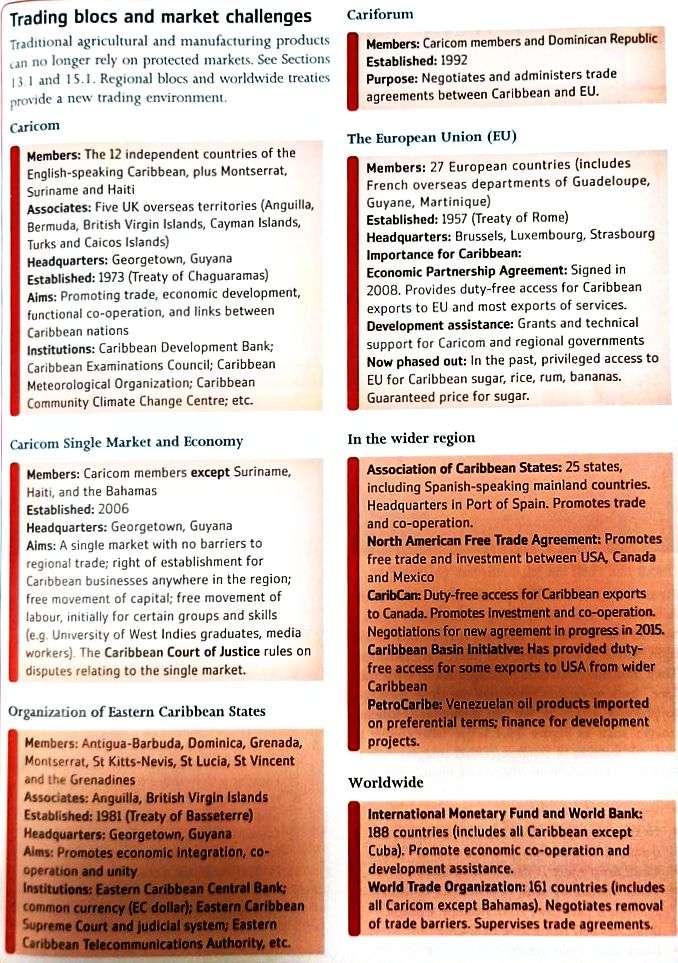
Many remarks you could notice :
- These islands are not able to compete in view of their economic characteristics, their small population and their geographical location, since they are subject to many natural hazards that affect these regions.
- The two systems CARICOM/CSME and OECS are mutually reinforcing. The OECS initiative is the stronger by reason of the common currency and monetary union. In CARICOM/CSME there is no other example of a common currency (Jamaica, Guyana, Barbados dollar etc). This lack of a single currency creates problems for business.
- These islands are torn apart by two dominant organizations USCMA and European Union.
- The overseas departments of France don’t belong to any caribbean organizations. It’s pretty relevant and damaging because these french departments are depending on France and EU and could exchange their production and create link with the others islands for the energies’ supplies for exemple.
- The CBI is intended to facilitate the development of stable Caribbean Basin economies by providing beneficiary countries with duty-free access to the U.S. market for most goods. In fact, the purpose of the Agreement was to provide certain Central American and Caribbean countries with a number of tariff and trade advantages, thereby enabling them to thwart the left movements active in the region such as the guerrilla movement of El Salvador or the Sandinism in Nicaragua which can sprawl in the basin.
The exemple of OECS
Watch the short presentation of the OECS from OECStv called ‘OECS Integration explained’
1. To what extent is the OECS area integrated?
2. Do some research to find out what does the members countries have in common?
3. Which organization proceeded the OECS?
4. Which country devised that organization?
5. Make an hypothesis about the reason why OECS is more integrated than Caricom.
6. Give a definition of integration in watching this short presentation
HERE THE MAIN FAETURES OF THE CARIBBEAN ECONOMIES
| Feature | Description/Reasons |
| High Degree of Openness | – Low resource base – Heavy reliance on external trade. – High trade dependency ratio – Low potential for export activity based on natural resource endowments. Example, only 22% (approx.) of total production in Barbados is based on natural/physical resources of the country such as agriculture, mining/quarrying and tourism. |
| Small Markets | – Small markets for product and export. – Import Substitution is not a viable option. – Limited economies of scale and scope. – Economies of scale may however be achieved in transportation, distribution and advertising cost in the domestic market but not for export, given quantity of export is small compared to an international export market. – Production alternatives limited. – Limited labour markets which encourage the generalist rather than specialised worker. |
| Mono-Culture/Export Concentration | – Few goods produced for export. – Economy is not large enough to capitalise on economies of scale for expansion and diversification. (But still cannot rely on a few exports. This is the dilemma of being a small economy). – Export usually concentrated in primary products |
| Physical Shock/Natural Disasters | Prevalence of natural disasters, especially hurricanes can wipe away economic gains and devastate infrastructure. |
| Economic Shock | More exposed to economic and market fluctuations and high terms of trade volatility than larger economies which not only have large domestic markets to absorb shock/change but international markets. |
| Trade Taxes dependency | -Trade taxes (customs revenue) make up large portions of the revenue base the economy. – Reduction in tariffs due to trade liberalisation therefore threatens economic substantiality due to lost of customs revenue. |
| Trade dependency | – Preferential access for Caribbean products/goods through Lome (African- – Caribbean-Pacific-European Union), Caribbean Basin Initiative (CBI) and Caribbean-Canada (CaribCan) trade arrangements. – Preferential access arrangements did not promote product diversification and competition as only some products were guaranteed and those were produced. – Preferential access encouraged mono-culture economic base and primary commodity production. – Primary products losing market share to information and service goods |
To thwart against these numerous drawbacks the caribbean countries found solution inside the CARICOM and the OECS.
- a single market in the caricom organisation with free movement of capital, labor.
- a same currency inside the OECS which facilitate exchanges and transportation,
- partnerships with EU,
- Basin caribbean initiative an agreement with the US which simplify the entry in the us market of some products gennerally raw materials.
- decrease of taxes and barriers.